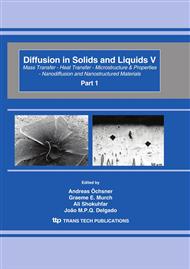p.93
p.97
p.105
p.111
p.117
p.126
p.132
p.142
p.148
Simultaneous Wicking-Convection Heat Transfer Process with Non-Newtonian Power-Law Fluid
Abstract:
In this work, we have theoretically analyzed the heat convection process in a porous medium under the influence of spontaneous wicking of a non-Newtonian power-law fluid, trapped in a capillary element, considering the presence of a temperature gradient. The capillary element is represented by a porous medium which is initially found at temperature and pressure . Suddenly the lower part of the porous medium touches a reservoir with a non-Newtonian fluid with temperature and pressure . This contact between both phases, in turn causes spontaneously the wicking process. Using a one-dimensional formulation of the average conservation laws, we derive the corresponding nondimensional momentum and energy equations. The numerical solutions permit us to evaluate the position and velocity of the imbibitions front as well as the dimensionless temperature profiles and Nusselt number. The above results are shown by considering the physical influence of two nondimensional parameters: the ratio of the characteristic thermal time to the characteristic wicking time, , the ratio of the hydrostatic head of the imbibed fluid to the characteristic pressure difference between the wicking front and the dry zone of the porous medium, , and the power-law index, n, for the non-Newtonian fluid. The predictions show that the wicking and heat transfer process are strongly dependent on the above nondimensional parameters, indicating a clear deviation in comparison with and n = 1, that represents the classical Lucas-Washburn solution.
Info:
Periodical:
Pages:
117-125
Citation:
Online since:
April 2010
Authors:
Price:
Сopyright:
© 2010 Trans Tech Publications Ltd. All Rights Reserved
Share:
Citation:


